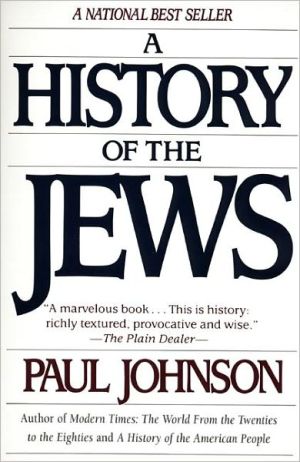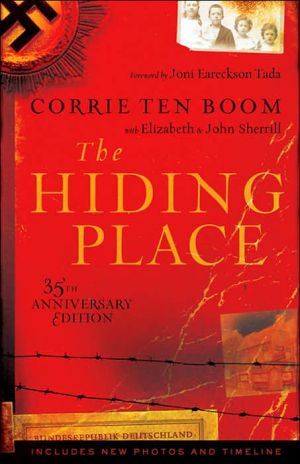History of the Jews
A national bestseller, this brilliant 4000 year survey covers not only Jewish history but he impact of Jewish genius and imagination on the world. By the author of Modern Times: The World From the Twenties to the Eighties.\ \ \ A brilliant and comprehensive one-volume survey covering four thousand years of Jewish history and the impact of Jewish genius and imagination on the world.\
Search in google:
A national bestseller, this brilliant 4000 year survey covers not only Jewish history but he impact of Jewish genius and imagination on the world. By the author of Modern Times: The World From the Twenties to the Eighties. New York Review of Books An extraordinary amount of useful information.
Chapter One\ \ Israelites\ \ \ \ The Jews are the most tenacious people in history. Hebron is there to prove it. It ties 20 miles south of Jerusalem, 3,000 feet up in the Judaean hills. There, in the Cave of Machpelah, are the Tombs of the Patriarchs. According to ancient tradition, one sepulchre, itself of great antiquity, contains the mortal remains of Abraham, founder of the Jewish religion and ancestor of the Jewish race. Paired with his tomb is that of his wife Sarah. Within the building are the twin tombs of his son Isaac and his wife Rebecca. Across the inner courtyard is another pair of tombs, of Abraham's grandson Jacob and his wife Leah. Just outside the building is the tomb of their son Joseph.' This is where the 4,000-year history of the Jews, in so far as it can be anchored in time and place, began.\ Hebron has great and venerable beauty. It provides the peace and stillness often to be found in ancient sanctuaries. But its stones are mute witnesses to constant strife and four millennia of religious and political disputes. It has been in turn a Hebrew shrine, a synagogue, a Byzantine basilica, a mosque, a crusader church, and then a mosque again. Herod the Great enclosed it with a majestic wall, which still stands, soaring nearly 40 feet high, composed of massive hewn stones, some of them 23 feet long. Saladin adorned the shrine with a pulpit. Hebron reflects the long, tragic history of the Jews and their unrivalled capacity to survive their misfortunes. David was anointed king there, first of Judah (II Samuel 2:1-4), then of all Israel (II Samuel 5:1-3). When Jerusalem fell, the Jews were expelled and it was settled by Edom. It wasconquered by Greece, then by Rome, converted, plundered by the Zealots, burned by the Romans, occupied in turn by Arabs, Franks and Mamluks. From 1266 the Jews were forbidden to enter the Cave to pray. They were permitted only to ascend seven steps by the side of the eastern wall. On the fourth step they inserted their petitions to God in a hole bored 6 feet 6 inches through the stone.\ Sticks were used to push the bits of paper through until they fell into the Cave.' Even so, the petitioners were in danger. In 15 18 there was a fearful Ottoman massacre of the Hebron Jews. But a community of pious scholars was re-established. It maintained a tenuous existence, composed, at various times, of orthodox Talmudists, of students of the mystic kabbalah, and even of Jewish ascetics, who flogged themselves cruelly until their blood spattered the hallowed stones. Jews were there to welcome, in turn, the false Messiah, Shabbetai Zevi, in the 1660s, the first modern Christian pilgrims in the eighteenth century, secular Jewish settlers a hundred years later, and the British conquerors in 1918. The Jewish community, never very numerous, was ferociously attacked by the Arabs in 1929. They attacked it again in 1936 and virtually wiped it out. When Israeli soldiers entered Hebron during the Six Day War in 1967, for a generation not one Jew had lived there. But a modest settlement was re-established in 1970. Despite much fear and uncertainty, it has flourished.\ So when the historian visits Hebron today, he asks himself: where are all those peoples which once held the place? Where are the Canaanites? Where are the Edomites? Where are the ancient Hellenes and the Romans, the Byzantines, the Franks, the Mamluks and the Ottomans? They have vanished into time, irrevocably. But the Jews are still in Hebron.\ Hebron is thus an example of Jewish obstinacy over 4,000 years. It also illustrates the curious ambivalence of the Jews towards the possession and occupation of land. No race has maintained over so long a period so emotional an attachment to a particular corner of the earth's surface. But none has shown so strong and persistent an instinct to migrate, such courage and skill in pulling up and replanting its roots. It is a curious fact that, for more than three-quarters of their existence as a race, a majority of Jews have always lived outside the land they call their own. They do so today.\ Hebron is the site of their first recorded acquisition of land. Chapter 23 of the Book of Genesis describes how Abraham, after the death of his wife Sarah, decided to purchase the Cave2 of Machpelah and the lands which surrounded it, as a burying-place for her and ultimately for himself. The passage is among the most important in the entire Bible, embodying one of the most ancient and tenaciously held Jewish traditions, evidently very dear and critical to them. It is perhaps the first passage in the Bible which records an actual event, witnessed and described through a long chain of oral recitation and so preserving authentic details. The negotiation and ceremony of purchase are elaborately described. Abraham was what might now be termed an alien, though a resident of long standing in Hebron. To own freehold land in the place he required not merely the power of purchase but the public consent of the community. The land was owned by a dignitary called Ephron the Hittite, a West Semite and Habiru of Hittite origin. 3 Abraham had first to secure the formal agreement of the community, ,the children of Heth', 'the people of the land', to make the transaction; then to bargain with Ephron about the price, 400 shekels (i.e. pieces) of silver; then to have the coins, 'current money with the merchant', weighed out and handed over before the communal elders.\ This was a memorable event in a small community, involving not merely transfer of ownership but change of status: the ritualistic bowings, the dissimulations and false courtesies, the hardness and haggling, are all brilliantly conveyed by the Bible narrative.
\ New York Review of BooksAn extraordinary amount of useful information.\ \ \ \ \ Publishers Weekly - Publisher's Weekly\ Less a seminal contribution than a distillation of a wide range of sources, this history of the Jews focuses on their four-millennia interplay with, and adaption to, other, often hostile, civilizationsa ``world history seen from the viewpoint of a learned and intelligent victim.'' Weaving biblical and archeological data, Johnson (Modern Times and A History of Christianity is particularly deft at placing the patriarchs and early Israelites (the Bronze Age through the destruction of the First Temple) in their historical context. His dense, somewhat arbitrary, capsule extols Judaic rational scholarshipwhich contributed to ethical monotheism and the 18th-century economic system, in turnand denigrates mystic kabbalah``heresy of the most pernicious kind.'' Although Johnson, who seeks to acknowledge ``the magnitude of the debt Christianity owes to Judaism,'' traces ``an inherent conflict'' between the religion and the state of Israel through the various ages, the work is incontrovertibly sympathetic to Zionism. BOMC and QPBC featured alternates; author tour. (April)\ \ \ Library JournalFamous author-historian Johnson ( Modern Times, LJ 5/1/83; A History of Christianity, LJ 7/76) presents a provocative history of the Jewish people, religion, and culture from earliest times to the present. Astutely divided into seven sections, (Israelites, Judaism, Cathedocracy, Ghetto, Emancipation, Holocaust, and Zion), the work describes the complex interplay between Jewish and world history and shows how the course of Western civilization has been immensely influenced by this numerically small group. It's no mean feat to successfully compress 4000 years of history into 645 pages, but Johnson has more than met the challenge. Despite a few reservationsE. G. Johnson's theories regarding Jesus and the incipient Christian movement are debatablethis is an excellent, nonscholarly history for general readers. Highly recommended for public libraries. Robert A. Silver, Shaker Heights P.L., Ohio\ \








